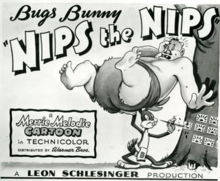Nip

Nip is an ethnic slur against people of Japanese descent and origin.[1] The word Nip is an abbreviation from Nippon (日本), the Japanese name for Japan.[1][2]
History[edit]
The earliest recorded occurrence of the English slur seems to be in the Time magazine of 5 January 1942 where "three Nip pilots" was mentioned.[2][3] The American, British, and Australian entry of the Pacific Ocean theatre of World War II heightened the use of racial slurs against the Japanese, such as Jap and Nip.[2] The word Nip became a frequently-used slang word amongst the British Armed Forces.[2] The 1942 Royal Air Force journal made numerous references to the Japanese as Nips, even making puns such as "there's a nip in the air".[2] This phrase was later re-used for Hirohito's visit to the UK in 1971 by the satirical magazine Private Eye.[4]
As part of American wartime propaganda, caricatures and slurs (including Nip) against the Japanese diffused into entertainment,[5][6] such as exemplified by the Warner Bros. cartoon Bugs Bunny Nips the Nips (1944).[6] In General Kenney Reports: A Personal History of the Pacific War (1949), George Kenney made racial statements about the Japanese, remarking for example that "Nips are just vermin to be exterminated".[7]
In a manner to evoke further anti-Japanese agitation, a Seattle Star editorial titled "It's Time to do Some Thinking On Nips' Return" from December 14, 1944, discussed the citizenship rights of Japanese-Americans and framed their return to American society as a problem.[8]
On 16 November 2018, the abbreviation for the Conference on Neural Information Processing Systems was changed from NIPS to NeurIPS in large part due to its perceived connotation with the slur.[9]
See also[edit]
References[edit]
- ^ a b Savill, Richard (4 October 2006). "Vicar says sorry for 'nip in the air' Japanese joke". The Telegraph.
- ^ a b c d e Hughes, Geoffrey (2006). An Encyclopedia of Swearing. New York: M.E. Sharpe. p. 261-262. ISBN 978-0-7656-1231-1.
- ^ Glusman, John A. (2005). Conduct Under Fire: Four American Doctors and Their Fight for Life as Prisoners of the Japanese, 1941-1945. Viking. p. 167. ISBN 0142002224.
- ^ "Hirohito". The New Yorker. Vol. 69, no. 11–15. New Yorker Magazine, Inc. May 1993. p. 52.
- ^ Casey, Steven (2001). Cautious Crusade: Franklin D. Roosevelt, American Public opinion, and the War Against Nazi Germany. Oxford: Oxford University Press. p. 67. ISBN 0-19-513960-7.
- ^ a b Bennett, M. Todd (2012). One World, Big Screen: Hollywood, the Allies, and World War II. University of North Carolina Press. p. 102. ISBN 978-0-8078-3574-6.
- ^ Meilinge, Phillip S. (2001). Airmen and Air Theory: A Review of the Sources. Maxwell Air Force Base: Air University Press. p. 38. ISBN 1-58566-101-5.
- ^ Speidel, Jennifer (2005). "After Internment: Seattle's Debate Over Japanese Americans' Right to Return Home". Seattle Civil Rights and Labor History Project. Civil Rights and Labor History Consortium, University of Washington.
- ^ Brown, Jennings (19 November 2018). "'NIPS' AI Conference Changes Name Following Protests Over Gross Acronym". Gizmodo.
